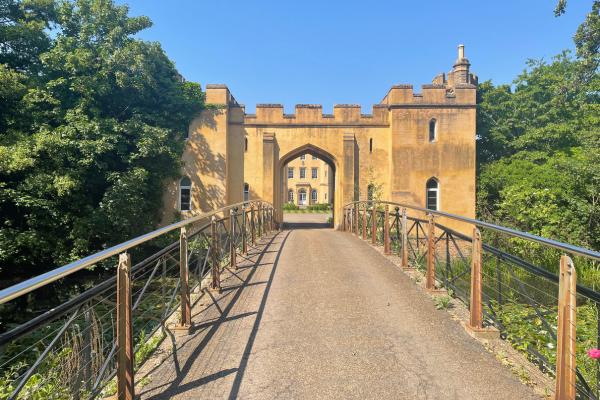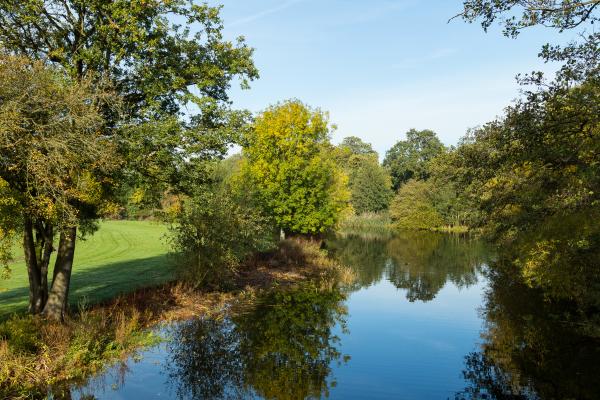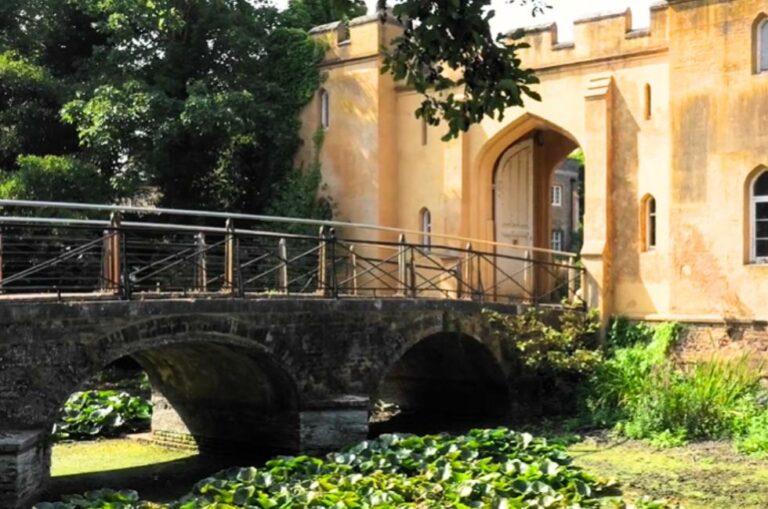The history and facts about moats have always fascinated us here at Ditton Manor, and we’re proud to still have a fully intact moat surrounding our wonderful property here in Berkshire.
Having a moat here not only adds historical charm but also enhances the beauty of our venue, and our guests love it!
Here’s everything you need to know about moats from our experience in maintaining our own moat, and from our historical investigations into the topic.

Key Takeaways:
- Discover the origins and inventors of moats.
- Learn about the different materials used to create moats.
- Explore the effectiveness of moats in historical defence.
- Find out if moats were ever stocked with fish.
- Enjoy some intriguing and fun facts about moats.
The Origins: Who Invented Moats?
Moats have a long and storied history, dating back to ancient times and were first recorded as being used by early civilizations such as the Egyptians and Mesopotamians.
However, it was during the medieval period that moats became a defining feature of castles and fortifications in Europe.
These medieval moats were often a part of a comprehensive defence system. The concept was later refined by engineers and military strategists throughout the Middle Ages.
Thus, while no single person can be credited with inventing the moat, its development was a collective effort over centuries.
Composition: What Are Moats Made Of?
Moats can be made of various materials depending on their location and purpose.
The most common type of moat is filled with water, creating a significant obstacle for attackers. These water-filled moats often sourced water from nearby rivers or springs.
Some moats were dry and lined with sharp stakes or other defensive structures. These dry moats, also known as ditches, were easier to construct and maintain than their water-filled counterparts.
They provided an additional layer of defence without the complexity of water management.
In some cases, moats combined both water and earth elements. These hybrid moats featured sections of water and dry ditches, maximizing defensive capabilities.
This design versatility made moats a flexible defence solution in various environments.

Effectiveness: Did Moats Really Work for Defence?
The primary purpose of moats was to protect against invaders. They served as a formidable barrier that hindered enemy troops and siege equipment.
This use of moats underscores their significance in medieval military architecture as moats were highly effective within medieval defence strategies.
They served as physical barriers that slowed down and impeded attackers. The presence of a moat made it challenging for enemy forces to reach the castle walls or gates.
Moats also enhanced the effectiveness of other defensive measures. Archers and defenders positioned on the castle walls could target enemies more easily from a distance.
The moat forced attackers to navigate a difficult and dangerous terrain before even reaching the walls.
However, the effectiveness of moats varied depending on their design and maintenance. Well-constructed moats with deep water or treacherous dry ditches provided excellent protection.
Poorly maintained moats or those with shallow water were less effective and could be overcome by determined attackers.
Wildlife: Did Moats Have Fish?
Yes, some moats did have fish. Stocking moats with fish served multiple purposes.
Fish helped keep the water clean by consuming algae and other organic matter. This natural maintenance reduced the need for human intervention.
Additionally, fish provided a source of food for the castle’s inhabitants. During sieges, access to fresh food could be limited, and having a stocked moat ensured a reliable food supply.
This practical use of moats highlights their multifunctional role in medieval life.
Not all moats contained fish, though.
The decision to stock a moat with fish depended on the availability of resources and the specific needs of the castle’s residents.
Nonetheless, the presence of fish in moats is a fascinating aspect of their history and many moats today still contain plenty of fish – just like out moat here at Ditton Manor.

Intriguing Tidbits: Fun Facts About Moats
Moats were not just about defence; they also had aesthetic and recreational uses. In some cases, moats were integrated into elaborate garden designs, adding beauty to the landscape.
These ornamental moats reflected the wealth and status of the castle’s owner.
The word “moat” comes from the Old French word “mote,” meaning mound or embankment.
This linguistic origin highlights the moat’s function as an earthwork structure. The evolution of the term underscores the historical significance of moats in European culture.
In modern times, moats have found new uses in various contexts.
Some tech companies refer to their competitive advantages as “moats,” emphasising their role in protecting market share.
This metaphorical use of the term illustrates the enduring legacy of moats in contemporary language.
Facts About Moats | Our Final Observations!
At Ditton Manor, we believe that understanding the history and significance of moats adds a unique dimension to appreciating our venue.
Our beautiful moat not only serves as a historical reminder but also enhances the picturesque surroundings of our property.
From ancient defences to modern metaphors, moats have played an essential role in shaping human history and we hope this guide has deepened your appreciation for these fascinating structures.
Facts About Moats | FAQs
How were moats maintained?
Moats were regularly cleaned to remove debris and sometimes stocked with fish to help keep the water clear.
Are there any famous castles with notable moats?
Yes, castles like the Tower of London and Bodiam Castle are renowned for their impressive moats.
Did all castles have moats?
No, not all castles had moats; the presence of a moat depended on the location and specific defensive needs.
Were there any special ceremonies or events involving moats?
In some cases, moats were used for festive events and pageantry, adding to the castle’s grandeur.
Can moats be found in modern architecture?
Yes, some modern estates and luxury properties incorporate decorative moats as a nod to historical design.



